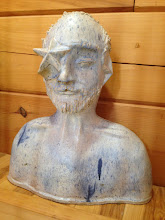Rob and Amy in the process of loading.

The shelves used are two sizes, 12 x 24 and 24 x 24 inch. Here Amy is moving one of the big shelves into place.

The post we use are sections of brick. One of the issues with salt firing is that the salt glaze goes everywhere. If you do not use a material that will not accept the glaze, all the bricks, shelves and ware will glaze together. So part of the loading process is "wadding". This means placing balls or logs of the material between everything. This material chips or grinds off after the firing. This is the white material you can see in the picture below.

Here are the plates after they have been glazed ready to be loaded.

We are always looking for that perfect glaze. Shown here are test "tiles" ready to go into the firing. The tests this time are for two new "recipes" from other potters and a series of the same base glaze with the amount of the coloring oxide, cobalt carbonate varied. There are so many variables in making a great glaze, you have to test, test and do more tests.

Here is a view in one of the "spy" holes. The "cones" you see are manufactured to consistently bend when the have been heated a given amount. We judge if the clay has hardened enough and the glazes have melted by watching these.

We also use a pyrometer as can be seen by the box to the right. This measures temperature through probes into the kiln. This gives an instantaneous view of how things are going versus the long term view provided by the cones.

After all the loading is done, the door is closed up by stacking bricks.

And now its on to the actual firing, which started very early this morning at about 5:45 AM. Now, which is 10:30 Am the temperature in the kiln is 690 F in the top and about 400 F in the bottom of the kiln. In the beginning, the temperature is often quite different top to bottom, but as the end gets closer, the temperatures get closer. Off to take a shift at stoking!

No comments:
Post a Comment